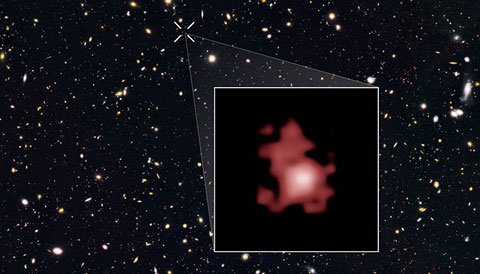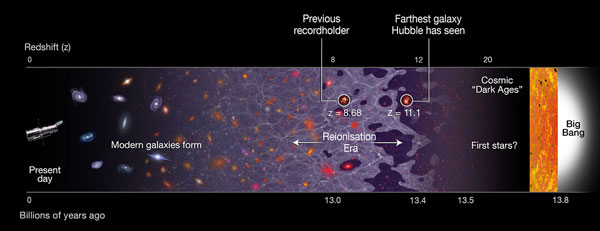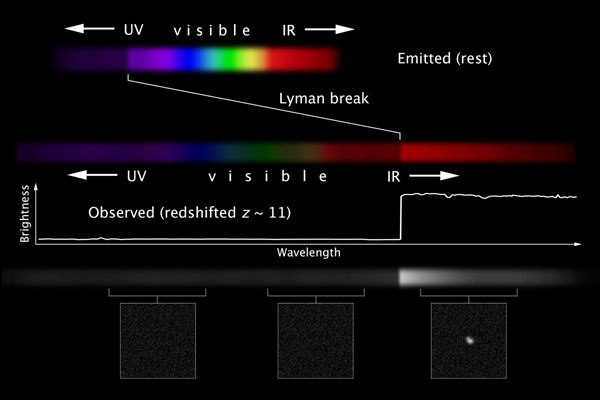Astronomers using the Hubble Space Telescope have measured a precise distance to a galaxy dwelling in the cosmic dawn.

NASA / ESA / P. Oesch / G. Brammer / P. van Dokkum / G. Illingworth
Does the title give you a sense of déjà vu? Surely, you might think, we’ve probed the farthest stretches of the universe before. And we are indeed approaching the limit to what the Hubble Space Telescope can see of the cosmic dawn — yet the fortune-favored satellite still has some surprises in store for us.
Astronomers had already used Hubble to find hundreds of galaxies that existed less than 1 billion years after the Big Bang, as well as a handful that were around even earlier than that. Now, observations have zeroed in with greater precision than ever before on one particular object that breaks all previous distance records: a humdinger of a galaxy dubbed GN-z11 that dwells in a universe just 400 million years old (at a redshift of 11.1, in astronomer-speak).
Though the universe only started forming stars when it was about 100 million years old, this galaxy already holds a billion Suns’ worth of mass in its stars. It’s churning out even more at a rate between 14 and 34 solar masses a year — dozens of times higher than Milky Way’s stars formation rate.
"It's amazing that a galaxy so massive existed only 200 million to 300 million years after the very first stars started to form,” said Garth Illingworth (University of California, Santa Cruz) in a press release. “It takes really fast growth, producing stars at a huge rate, to have formed a galaxy that is a billion solar masses so soon."

NASA / ESA / B. Robertson / A. Feild
Thanks to its stars, GN-z11 is incredibly luminous, radiating three times the ultraviolet light typical of galaxies in that early era. That trait was key to measuring its distance with such high precision.
Once More, With Precision
When galaxies lie so far away, not only do they appear faint, but their light also shifts redward, the wavelengths stretching out as they traverse space and time. Light that was initially emitted at ultraviolet wavelengths has lengthened to infrared radiation by the time it arrives at Hubble’s detectors.
Astronomers measure distance to these faraway galaxies by looking for a clear imprint in their spectra. Hydrogen that fills the early universe absorbs virtually all light at wavelengths shorter than 121 nanometers. So while a galaxy’s light at longer wavelengths may pass through the universe relatively unmolested, light at wavelengths shorter than that magic number will disappear, absorbed into interstellar and intergalactic gas.

NASA / ESA / C. Christian and Z. Levay
Locating this break in a spectrum gives astronomers an easy measure of how far a galaxy’s light has shifted redward — its spectroscopic redshift. But easy is only as easy does: Hubble’s deep looks capture regions of space teeming with faint and faraway galaxies (such as CANDELS), and it’s far from easy to take the spectrum of every object in the field of view.
Instead astronomers collect the poor man’s version of a spectrum by taking pictures of the same field at many different wavebands. They locate the drop-off in light when they see a galaxy disappear from images taken at shorter wavebands. This process gives an object’s so-called photometric redshift.
But photometric redshifts can be deceiving. A previous record-holder for the “most distant galaxy” title had the lovely name UDFj-39546284. Its photometric redshift of 11.9 placed it in a universe just 380 million years old. But follow-up spectra called that result into question: the galaxy might actually lie much closer to Earth than originally thought. The next most distant galaxy has a photometric redshift of 10.7.
Spectroscopic redshifts remain the golden standard for measuring distance — it’s just been difficult to find galaxies bright enough to pass through a spectrograph with a legible result. GN-z11 happens to be exceptionally bright, and that’s what enabled Pascal Oesch (Yale) and his team to measure its redshift so precisely. The result will be published in the Astrophysical Journal.
This result may represent the edge of Hubble’s reach, but it’s only the beginning when it comes to future telescopes such as James Webb and WFIRST, whose longer-wavelength detectors will probe hundreds of galaxies even further back in cosmic time.
Watch the video below to find the whereabouts of this galaxy in your night sky:
 2
2









Comments
March 7, 2016 at 12:23 am
As a regular non scientist who loves science, I can't help but ask this question. Don't get aggravated, please. How do we know for sure how old the universe is, or how far it extends beyond what we can now see? Do we believe it is around 14 billion yrs. old because that it all the farther we can see? Thanks to anyone who can explain this to me.
You must be logged in to post a comment.
March 10, 2016 at 11:28 pm
Observational evidence shows that the universe is expanding. That evidence also aided by our current mathematical model of the universe permits us to reconstruct past values of the rate of expansion. Therefore, following this expansion history in reverse leads to a point in time when the universe contracts (remember, we are following time in reverse) to a point and that corresponding time must have been the Beginning. Note, however, that this time depends in part upon the best current mathematical model. Change a parameter in that model and the age changes. That happened some years ago when it was discovered that the rate of expansion is currently INcreasing, not decreasing as had been believed previously. I hope this helps.
You must be logged in to post a comment.
You must be logged in to post a comment.